Here are a bunch of photos that I have never seen much of- Ben Hogan on his way to victory in the 1953 British Open Championship- The ONLY Open he ever competed in
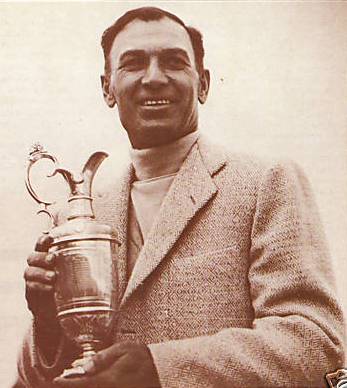
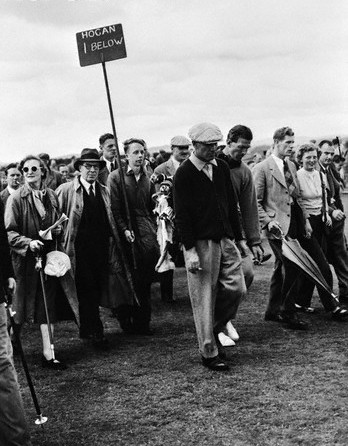
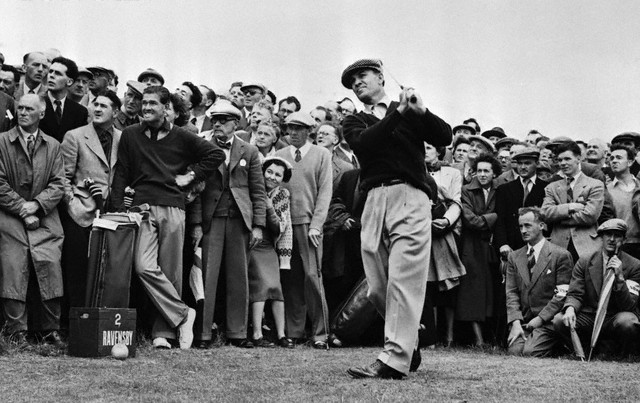
More pics of Hogan at The 1953 Open
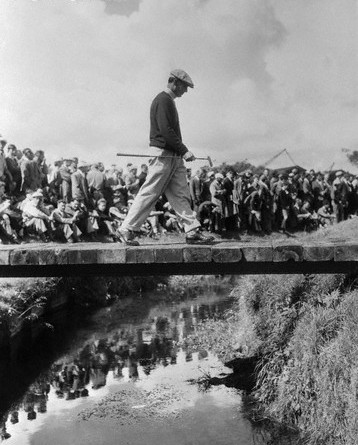

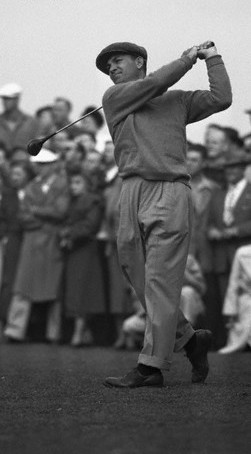
More pics of Hogan at The 1953 Open
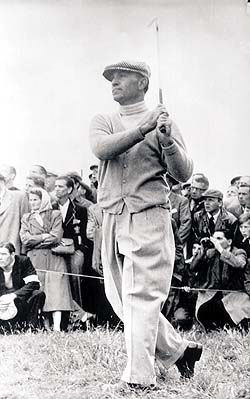
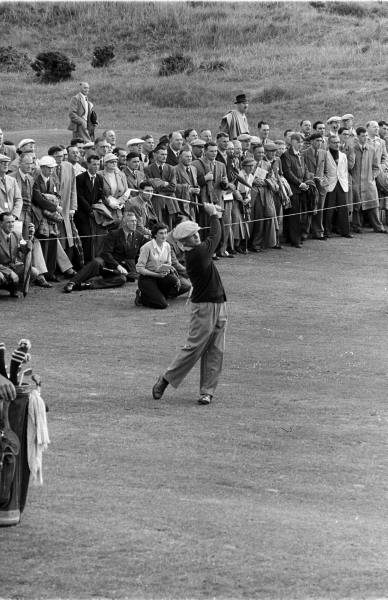
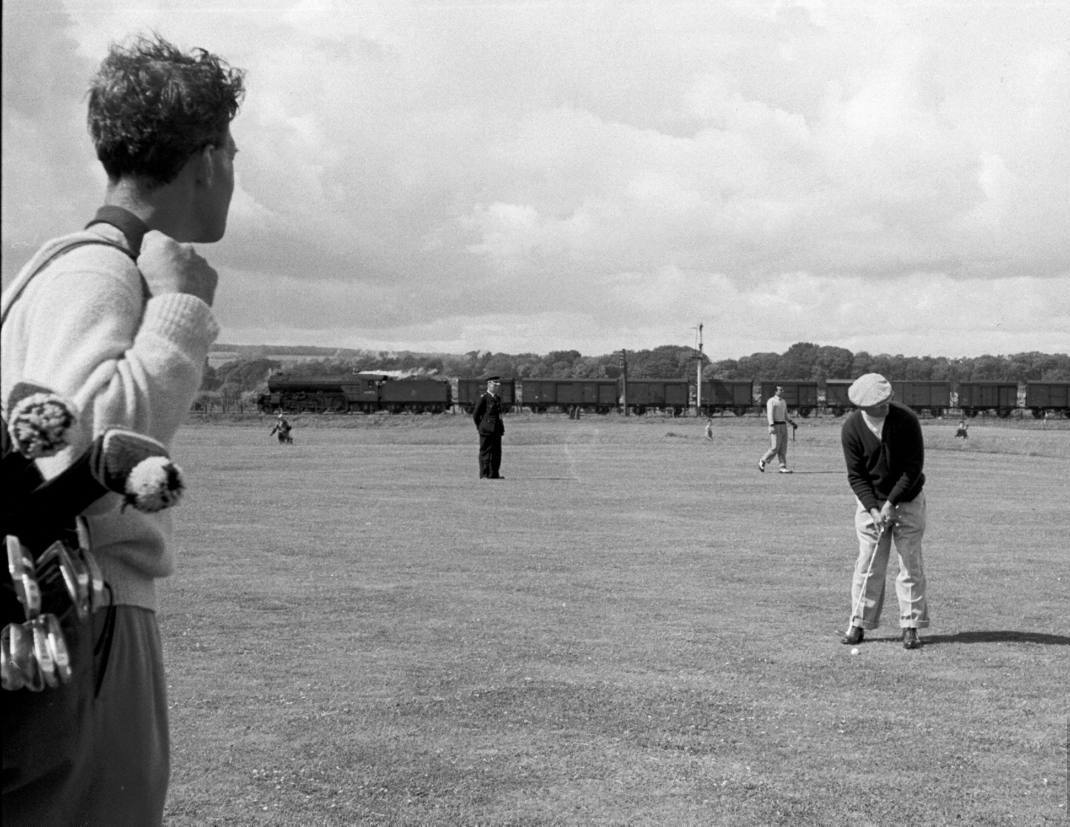
More pics of Hogan 1953 Open at Carnoustie
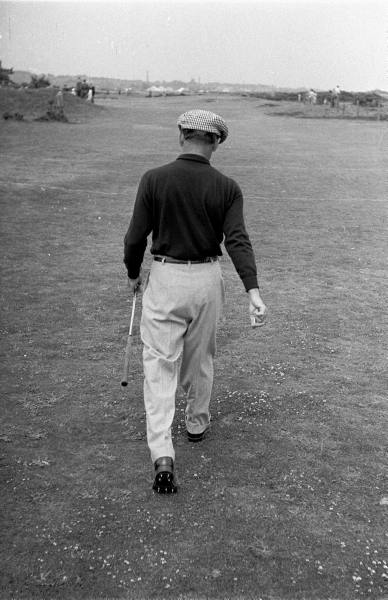
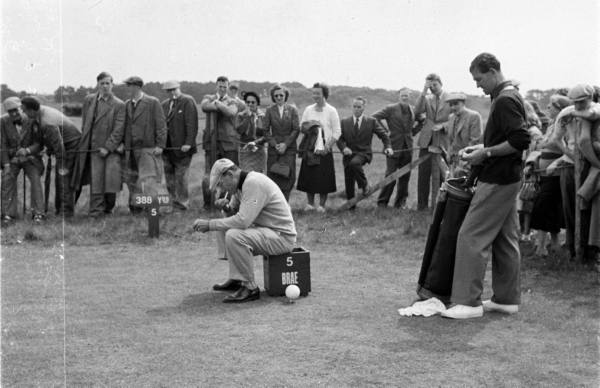
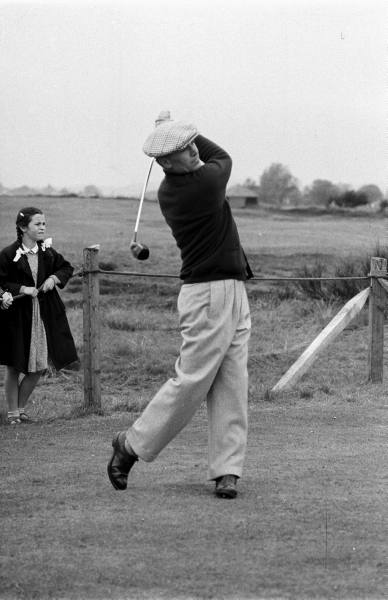
Hogan at Carnoustie 1953 Open Championship


Part 1 of Hogan and his quest to win the British open
Ben Hogan was forty years old and playing the finest golf of his life in 1953. thus the timing appeared to be perfect for his first and only attempt to win The British Open.
Not since Willie Park in the initial event in 1860 had a golfer won the British Open on his first try, and as well as he was playing, Hogan knew there was no guarantee of victory accompanying his entry.
“I began to feel a pressure that I’ve never before experienced about a tournament”, he said “You know, a great many people have built up in their minds a mythical Hogan who wins whenever he wants to win. Well, it does not work out that way. that’s just not true”… “I found myself in a situation of proving I was as good a golfer as those who had won the British Open before me. As you get older you find yourself having to prove yourself again- and it eats on you. I think golfers would last longer and win more if this wasn’t so. Every place you go you are expected to play excellent golf, often super golf. It’s awfully hard to do that, but people won’t expect less”.
Even as these thoughts occupied his mind and the pressure built, Hogan won his 4th US Open at Oakmont, his score of 283 beating Sam Snead by six strokes. Then Ben focused his attention to the British Open.
At Oakmont, discussing the forthcoming foray to Scotland, Hogan commented that perhaps he would need some long underwear because of the cold weather on the east coast of Scotland. Ben also said it might be more comfortable if he could find some cashmere ‘long handles’. Especially since his accident, Hogan’s patched up body and redeveloped golf game suffered from cold and damp weather.
The week after his commenst, Ben received a wire from Abercrombie & Fitch, the New York store that specialized in equipment for sportsmen. The telegram informed Hogan that the store had cashmere long underwear and that he would be unable to find the item in Scotland.
The price was $95 a pair…Hogan telephoned a friend in New York City and had him order two pairs of the underwear and have them delivered to the hotel where Ben and Valerie would be staying in New York en route to Scotland. As it developed, Hogan could not wear the ‘long handles’ because they were TOO warm. He eventually kept one pair for hunting trips.
When news of his possible need for the underwear spread, well wishers and other firms began sending unsolicited gifts of the garments to Hogan. “Why I kept getting underwear sent to me until paying the duty on them almost broke me”
Ben Hogan could have come up with many excuses for bypassing the British open of 1953 and his stature in golf this side of the Atlantic would have been unaffected. The only way he was going to gain in Scotland was by winning. Hogan was not afraid of losing- he had learned to live with that years before.
What concerned him was that if he did not win, the people in Great Britain would think, ’ Well the American players aren’t as good as they are supposed to be’. These thoughts added to the pressure. Weighing all factors, it would have been an easy decision to stay home.
He has several reasons for going. He was determined to prove to himself that he could play the different course and weather conditions and maneuver the smaller British ball. he also was aware that Carnoustie was one of the toughest courses in the world.
“I’d heard so many comments that had come second hand to me that people didn’t believe I could play under those conditions, and I was somewhat determined to prove that I could. In that respect I think that’s been one of my driving forces because over a period of years people have said I couldn’t do this and I couldn’t do that, or I couldn’t play different type shots that are called for on a certain kind of course. Even at Colonial, my home course in Fort Worth, I heard several times that I couldn’t win this year because I wasn’t a very good wind player”
The wind was twenty five miles per hour steady with gusts up to forty miles per hour every day of the 1953 Colonial National Invitational and Hogan shot 282 to win by four strokes.
A third lesser reason for Ben’s decision to enter the British open was the standardization of golf rules achieved in 1952. The British under the uniform rules now permitted use of the center shafted putter after having banned it for many years. Hogan used a center shafted putter with a brass blade made from a melted down doorknob during World war II.
The prize money certainly was no incentive for Hogan to play. The purse had been increased but first prize was worth only $1400. Cary Middlecoff, later discussing his first effort in the British Open, remarked…‘Under the present setup over there you go over to play just for the glory. You have to finish first to make ends meet financially, and there’s no glory in finishing second. No one remembers the runner-up. It’s tragic, but that’s the way it is’.
Ben as non playing captain and Valerie had gone to England in 1949 with the United States Ryder Cup team. All travel arrangements and accommodations had been made for them on that trip, and food from the United States was shipped to England for the players and their wives.
This time the Hogans were responsible for arranging their own travel. They planned to fly to Prestwick on the west coast, and drive across Scotland to Carnoustie, spend three weeks there, go to Paris for a week’s vacation and then take the ocean liner SS United States back to New York. the National Cash Register Company offered Ben and Valerie lodging in it’s guest house at Dundee, eleven miles away from Carnoustie.
Hogan thought about having enough meat and vegetables for three weeks frozen and shipped over but he recalled that the English resented the Ryder Cuppers doing that in 1949. “So I didn’t do it”, he explained. “I didn’t want the papers or someone raise a stink about it”.
Ben had started playing the Titleist golf ball even before severing connections with MacGregor Sporting Goods, and the Acushnet company, makers of Titleist, geared up and produced dozens of British size golf balls for Ben to use at Carnoustie. The British ball weighs the same as the United States ball, 1.62 ounces, but at 1.62 inches is .06 of an inch smaller in diameter. The difference in figures is minute, but the difference in distance, especially in a heavy wind, is enormous.
Lloyd Mangrum and Frank Stranahan, the fine amateur who always played well in Great Britain, were two other Americans entered. It was to be Mangrum’s first bid too, although he was generally overlooked in the excitement of Hogan’s entry. Personality differences seldom took precedence over respect for another’s golfing skill among the top American professionals and Mangrum was no exception.
When Hogan departed New York for Scotland, Mangrum said…“If I can’t win I hope Ben Hogan does. This would be a great thing for Hogan, who has won all of our major titles in this country”.
Here’s some nice newsreel of that 1953 Open
Part 2 of Hogan and his quest to win the British open
When they first arrived at Prestwick, and for a few days after that, Ben and Valerie had difficulty understanding the Scottish brogue and the wording of questions. Ben consented to a press conference upon arrival at Prestwick. One man acted as spokesman for the reporters.
“He’d ask something and I wouldn’t know what to say. I’d have to think for five minutes to figure out what he meant by his question because they didn’t word them the way we do”.
The spokesman asked Hogan if there was any special significance to the tie he was wearing. Ben did not know what he meant by that either. Hogan glanced down at his tie and said no. Then the spokesman pointed out that Ben was wearing a tie of red, white and blue colors.
Ben rented a Humber automobile and hired a chauffeur, John, who drove the Hogans across Scotland and remained in their service until they departed three weeks later.
When Hogan first saw Carnoustie, one of the ‘stoneage’ Scottish courses dating back to the birth of the game, he quickly understood why no golfer had ever won the British Open on his first try. The course was a drab looking mixture of browns and faded green colors with no trees. It looked to Ben like land that had never been developed since the year one.
“They just go out and seed a tee om the level ground and then seed a green the same way. In between they mow the grass for a fairway”, Ben described his impressions, “and that’s the way the course has been for two hundred years, and I suppose will be for two thousand more. They put bunkers in like a man throwing rice at a wedding. It looks like they took a handful of bunkers and threw them out over the course. Where they landed, there are bunkers… You never have a level lie. One time I’d be hitting with a baseball swing and the next time way down beneath my feet. Every fairway is rolling and full of mounds. There are no trees. I’d guess they mow the greens once a week, maybe, and the fairways once a month. Usually they let goats in on the fairways and they never touch the rough”.
Hogan planned his schedule to permit two weeks of practice, play and familiarization with bot the Carnoustie course, where the championship would be contested and the shorter Burnside course, where one qualifying round would be played.
Hogan came off the eighteenth green of his first practice tour of Carnoustie with misgivings. The fairways were hard and pockmarked with divot holes. The greens were hard, but heavy and slow where they appeared to him to be faster. This upset his putting rhythm and also forced him to play more hit and run approaches instead of flying the ball to the green. There were many blind shots to the greens and very few landmarks on the course where distance could be calculated.
It was completely different from the target golf of the United States, where courses have boundaries, or borders, of trees, fences and hedges, the fairways easily distinguishable from the rough and the greens usually well defined by surrounding trees, bunkers or ponds. Often when Hogan stood on the tee at Carnoustie and looked down the course, he could not tell where the fairway ended and the rough began.
Furthermore, the ground jarred his wrists when he tried to hit through the ball and the turf with his irons and he realized he would have to make an adjustment for that. All in all, the 7,200 yard duneland course close to the Firth of Tay and the North Sea did indeed loom as the ‘monster’ he had heard it called. So Hogan set about reshaping his game to the demands of the course.
In Hogan the Scots found a match for thier brusqueness. He told them about the greens…“You can’t putt on putty… I’ve got a lawn mower back in Texas, I’ll send it over”.
The Scots, proud of old Carnoustie, replied in kind with the suggestion that champions had always been able to adjust to their course. And that was what Hogan planned to do as he practiced in the mornings and played the course in the afternoons. On three of the days he only hit practice balls and did not play a round. He was having trouble getting used to the distance he could hit the smaller ball.
He kept talking about two clubs less- say a seven iron instead of a five iron- than he would with the American size ball and then hitting so hard that the ball quite often rolled over and beyond the greens. each day’s problems had him asking, “What am I doing here?” Hogan decided early that the tee shot would be the most important because of the type of course and the weather, and the necessity to keep the ball out of the heather and gorse.
“If you hit that rough you’re going to go for a 77 every round”… Ben did not even practice hitting shots from the heather and gorse in the rough because he believed that anyone whose ball landed there did not have a chance to win the tournament anyway. So he practiced much more with his woods than he normally did for US tournaments. On his practice rounds he hit three balls from each tee, one down the left side of the fairway, one down the middle, one down the right side- no mean feat in itself. he was learning not only how to negotiate the bunkers in the middle of the fairway but which positions offered the best approach to the greens.
Hogan played several practice rounds, however, before he learned that he was not hitting from all of the back tees that are used in the championship. They were far back in the gorse and heather and he had not found them. The championship tees are called tiger tees and Ben guessed the reason was that only tigers would frequent such areas. The tiger tees increased the length of the course from the standard 6701 yards to 7200 yards.
Hogan solved the problem of the bone jarring turf and sand filled divot holes by picking the ball off the ground much cleaner with his irons than he normally would. He decided there was only one solution to his inability to judge distance. Nearly every evening after dinner- it did not get dark until about eleven o’clock- he walked the Carnoustie course, often in reverse, eighteenth green to the first tee. He memorized the hazards, undulations, bunkers and shape and slope of the individual greens. In addition, in practice rounds he memorized what club was required from various places on the fairway, taking the weather and other factors into consideration.
He never got to the point where he trusted himself to look and judge whether he had a four iron shot or not. But he did trust his memory.
The Scots, some of them walking five or six miles to play a round in the twilight after closing their shops or completing their day’s farm chores, came to admire this solitary figure intently studying their course. They began to call him the ‘Wee Ice Mon’, and they recognized that he was a stern man for a stern game.
Hogan was being exposed to some customs quite different from those in United States golf as he continued his preparation. It surprised him that pin placements on the greens were unchanged throughout the two weeks of practice and the qualifying rounds. The cups were then moved for the start of the tournament proper but remained in the same position for the four rounds of competition.
He made several inquiries about registering for the tournament and obtaining credentials, but no-one could tell him the procedure. On the day before the tournament he received a letter in the mail with his ticket and a guest ticket for Valerie, plus the pairings for the qualifying rounds. This was the only communication he had from tournament officials and in fact he never saw an official of the British open until the last day of the event.
The first qualifying round was scheduled for Monday July 6 and Hogan played the shorter Burnside course. Hogan who could not work up a keen competitive pitch for qualifying rounds, scored a 70 at Burnside and a 75 the next day at Carnoustie and easily made the list of one hundred qualifiers for the tournament proper. Also in the field was a truly international cast including Bobby Locke, the defending champion, Peter Thomson of Australia, who was to win the event the following three years, Roberto DdVincenzo and Antonio Cerda from Argentina and Mangrum and Stranahan from the United States.
Dai Rees from Wales, harry Bradshaw and Fred Daly from ireland, Eric Brown, hector Thompson and John Panton from Scotland and a large English delegation headed by Max Faulkner a former titlist in the event, were among the British Isles representatives. Observers were terming it the finest British Open field of modern times as the tournament proper got underway on Wednesday July 8.
Another excellent British open footage reel and Hogan’s career after his accident and leading up to that Open
Part 3 of Hogan and his quest to win the British Open
The weather was cold and windy and there was occasional hail as the players trudged Carnoustie in the first round. In practice rounds Hogan had never hit more than a light eight iron second shot on the first hole. In the tournament’s first round because of the wind at his face, he nailed a driver and two iron as hard as he could and did not reach the green.
Hogan felt alright about his play in scoring a 73 in the first round because of the wind and the bounce and run shots he had to make. He was not satisfied with his putting however, and he was worried about his energy. He had been losing weight since February and had lost weight through the two weeks of practice at Carnoustie. The meal rations were small and the food, in his words, “awful”, and he tried to keep his strength bu eating a great deal of fruit.
Those familiar with Hogan’s hard to please eating habits could scarcely believe his getting along on lamb chops or mutton and the same three vegetables every day for three weeks and being served roast beef as thin as boiled ham only twice in that period. He would not touch the kidney pie.
The 73 left Hogan three strokes back of Stranahan going into the second round, where Hogan once again could bot drop his putts although he played well and scored a 71 for a thirty six hole total of 144. This was two strokes back of the co leaders, Rees with 72-70 and Brown with 71-71. DeVincenzo was at 143 and Hogan thought the powerful Argentinian’s tremendous distance off the tee might have everyone else playing for second. DeVincenzo might have run away with the tournament if he could have avoided trouble. Stranahan and Peter Thomson were at 144 with Hogan. Locke and Faulkner at 145.
Hogan’s caddy was Cecil Timms, who had been recommended by two United States amateurs, Harvie Ward and Dick Chapman. Timms was a good caddy, treated Hogan’s clubs like the crown jewels, kept his shoes shined, but may have made his greatest contribution by relieving some of the tension that Hogan naturally was experiencing.
Timmy, as he was called, was so nervous himself that Hogan found it necessary repeatedly to stop and talk to him and calm down his caddy. “For goodness sake just stand still and shut up”, Hogan told timms. “Aye; yes sir” was Timms repsonse. However on long putts the caddy would hold his head down between his arms and refuse to look. On other putts he might growl fiercely at the ball, make faces, jerk his arms wildly, and adapt various postures of 'body English". Hogan never asked a caddy what club to use but if he picked a five iron and the ball was short of the green and he commented that he should have taken more club, Timms would say, “I had me hand on the four iron, I did”.
Hogan was walking well ahead of Timms once when a rain squall hit and Ben stopped, waiting for his caddy to hurry up with the umbrella. When Hogan looked back, Timms was busy putting on his rain suit and by the time he came up with the umbrella Ben was soaking wet.
Hogan carried fruit drops in his bag each day to eat for energy. He doled out some to Timmy and said they were for him but that he would need to eat the rest. On the second round Timmy ate his share and Hogan’s too !! Ben bought some more and told his caddy to leave them alone. But soon they were all gone, and Hogan lectured the caddy sternly that he must leave the next jar of fruit drops alone. “But Mr Hogan”, Timms said, “I could eat them all day they’re so good”.
Hogan susceptible as usual to inclement weather, had a touch of the flu by friday morning and took a shot of penicillin before going out to Carnoustie for the final thirty six holes. he had other medicine but did not take it for fear of getting an upset stomach.
Carnoustie was crowded with more than twenty thousand people who had come from all over Scotland to watch this legendary golfer make his run at their championship.And back in the United States, not since D-day of 1944 had the public been so unanimously interested in an invasion of foreign soil. Golfers, golf fans, and people who did not know a driver from a putter were following Hogan’s progress. On the final day they telephoned newspapers and radio stations by the hundreds and thousands. Radios were turned on in homes, automobiles, drugstores, barbershops- everywhere- to catch the announcers who were giving almost hole by hole accounts of Hogan’s play.
’
Part 4 of Hogan and his quest to win the British Open
Although not wearing the long underwear, Hogan was bundled in more clothing than normal on the final day, which offered a mixture of cold winds, gray skies, occasional rain, and some sunshine. On his morning tour Ben had an excellent round going with a reading of of four under fours, moving to the seventeenth hole. There however, he shoved his second shot into a trap by the green, made a mediocre recovery and then three putted for a six. He got his four at the eighteenth for a 70 and after fifty-four holes was tied for the lead at 214 with DeVincenzo.
The latter also had a bad hole in scoring a 71 for his total of 214- hitting a ball out of bounds at the ninth hole. Hogan and DeVincenzo were one stroke ahead of Rees, Peter Thomson and Tony Cerda. Hogan had a number of players to worry about during the break for lunch.
Valerie bought lunch for Ben and herself and a thermos of coffee and told Timmy to take Hogan’s lunch to him in the locker room of one of the small clubhouse’s across the street from the course. The caddy was gone for a while and when he returned to Valerie he sat around watching her eat. She began to feel sorry for him and asked if he would like to share her lunch. Timms ate about half of Valerie’s sandwiches, and not until later did Valerie and Ben compare notes and discover that the caddy had been given half of both their lunches !
“So he ate a full lunch while Valerie and I each ate half a lunch,” Ben said
When the field was tightly bunched as it was entering the final round, Hogan always had a contingency plan in case it was necessary for him to take chances, and he always knew exactly which holes were the most conducive to any alteration in his pattern of play. Fortunately, DeVincenzo was playing six to eight holes ahead of him on the afternoon’s concluding eighteen, so keeping track of the Argentinian would be relatively easy. Rees and Thomson also were ahead of Ben, but Cerda was behind him, and Hogan recognized the smaller Argentinian as a serious threat also.
Hogan started with consecutive fours on the first four holes and his pretournament summation that 283 would win the tournament was at least within range. But a friend informed him that Cerda had birdied the third hole, and Hogan thought at the time he needed to shoot a 70 or within a stroke of that to win.
He wanted to get a couple of birdies somewhere and the first came in such an unorthodox manner that the adrenaline pumped through Hogan stronger than ever, the surging victory mood erased all thoughts or weariness or illness, and the British Open championship was practically decided. That first birdie came at the fifth hole, a slight dogleg to the right measuring 388 yards.
Hogan was now hitting the small ball up to 300 yards off the tee, and he cleared the bunker in the fifth fairway with ease. He played his approach to the side of the incline of the green, which was double-terraced and stretched about forty to fifty yards in length. The ball hit eighteen feet from the pin, but then rolled back off the green and stopped in the edge of a trap, about half in the sand and half out, caught by a couple of blades of grass.
Hogan did not like chipping out of sand and described it as the the hardest shot in the world for him to make. But he was fearful of trying to blast out and risk sending the ball over the green. With his right foot in the sand, his left on the grassy bank, he chipped the ball with a nine iron. He picked the ball cleanly and sent it scurrying upslope toward the cup. The ball skipped across the grass, banged against the back of the cup, bounced into the air three or four inches and then fell with a rattle into the hole for a birdie three.
“As luck would have it”, Ben said of the shot, “I hit it just right”
The skillful, yet fortunate, stroke put Hogan one shot ahead of Cerda and three ahead of DeVincenzo, who made the turn two over with a 38. Hogan was in the lead for the first time in the tournament and he brought to bear all his inner reserves to press the advantage. At the sixth hole, playing much longer than the listed 521 yards, he zapped two whistling wood shots to the edge of the green and birdied with a four.
Parring the next three holes, Hogan turned two under par with a 34 and learned that Stranahan and Rees were in with scores of 286 and that Thomson was not likely to do better than match that. Par in would give Hogan 284, so he was now interested in holding what he had and keeping track of Cerda behind him.
At the tenth hole , as Hogan was taking his stance on the tee, out of the corner of his eye he saw a dog walk across the tee about ten yards in front of him. He waited and thought he saw the dog walk into the crowd. But just as Ben hit a full driver the dog walked back across the tee. Hogan’s ball missed the dog by mere inches. He went onto par the tenth, eleventh and twelfth holes. Then he spanked a five iron tee shot 175 yards to the green at the thirteenth and rolled home a twelve foot putt for a birdie deuce.
He learned that DeVincenzo had finished at 287 and that Cerda was back at even par after a five at the twelfth, when his ball struck a spectator. Hogan was certain after the thirteenth that he had the championship if he did not do anything foolish on the finishing holes. He parred the next four holes, and as he teed off on the eighteenth, the seventy second of the tournament, the fairway was lined along its 450 yards with fans seven to ten deep. His drive was perfect, and his approach split the green. He two putted for a birdie, a 34 in, and a 68 and a 72 hole score of 282. The 68 was a new single round record for Carnoustie and the 282 was a record by eight strokes under the previous competitive best over the course.
Hogan who had forsaken his usual lightweight white cap for a warmer wool one, removed his cap, tipping it to the applauding crowd. the attitude of almost every skepticism that he first encountered around Carnoustie had changed to one of warm admiration and friendliness.
Valerie was unable to see Ben’s finish because of the crowds, but her thoughts were about his health. She insisted that John, the chauffeur, bring Hogan’s coat, and she made sure he put it on before walking out to receive the championship cup. Fatigue was evident on Hogan’s face.
Britain’s sportswriters unleashed every superlative…“Hail the greatest golfer of our time”, said the London Daily Herald, “And who shall say he is not the best of all time?”, wrote the Daily Telegraph, saying that the final two rounds of 70-68 showed that Hogan had the 'indefinable quality of being able to bring himself to his peak when the pressure is the greatest"
The London Daily Mail wrote, “Ben Hogan is the greatest golfer America has ever sent to our country, as every knowledgeable person in Scotland believed. It’s indisputable that he’s the best. He’s streets ahead of them all”.
“You know, we don’t call our Open the British Open, it’s TheOpen. We consider it a world’s championship, and it would have been grossly unfair had Ben not ever won it. He’s the finest player of a golf shot I have ever seen. Not only does he possess skill to make a shot with a minimum of error, but he also has mental command, mental control, under stress where most golfers of an equal skill do not”
“All in all, it was hard to imagine a victory which could have been more completely victorious”, golf historian Herbert Warren Wind wrote. “Perhaps that is why it had scarcely been achieved when it began to have a ring of a legend to it… Since he had never entered a British open before and since it was probable that he would never do so again, what had happened- his arrival in a strange land, the perfect completion of the task he had set himself, his succinct departure- seemed to be sealed off from all other events, suspended as it were, in a separate and somehow unreal land of it’s own, so that if it were not known for a fact that there had been a 1953 British Open on that remote stretch of duneland in Forfarshire, you might have thought that the whole story was the concoction of a garret-bound author of inspiration books for children who had dreamed up a golfing hero and a golfing tale which he hoped might catch on as had the exploits of Frank and Dick Merriwell in the days before golf was considered the proper vehicle for the dreams of glory of the red-blooded American boy”
Hogan who came to believe the tee shot is the most important in golf, was in the rough only ONE time in 108 holes, and that was in a qualifying round. He completely avoided the Barry Burn, a creek that runs around and across portions of the Carnoustie course before flowing into Carnoustie Bay. His was a superb example of preparation and execution.
Hogan did not putt really well the entire tournament and left the ball short of the hole frequently the first three rounds. And throughout the seventy two holes he never bounced an approach shot ‘stiff’ to the pin. He maneuvered the ball expertly, however, and his organization and management more than compensated for his putting problems.
The British Open was Hogan’s ninth Major championship and his sixth since his 1949 automobile accident. His two PGA titles were matchplay but in the four US Opens, two Masters and his British Open victories Hogan averaged 281.3 strokes per seventy two holes.
Hogan was not sanctimonious, nor a hypocrite, but he said after the British Open." I don’t think anybody does anything unless the Lord’s with them. I think it’s fate, and supposed to be, that I won these tournaments; otherwise, I wouldn’t have won them. All of these victories required more guidance than one human being can give another and I’ve been fortunate enough to receive that guidance. I think the Lord has let me win these tournaments for a purpose. I hope that purpose is to give courage to those people who are sick or injured and broken in body as I once was."
The US Open triumph at Merion in 1950 would always be prized the most by Hogan because it proved to him that despite the accident and the lasting damage to his legs he could still play major championship golf and win. But for sheer joy of triumph, the British Open ranked first.
“The British Open gave me my greatest pleasure. Certainly the others were pleasurable, but none of them gave me the feeling, the desire to perform, that gripped me in Scotland”
There were more years and more tournaments and more challenges ahead, but Hogan’s conquest at Carnoustie would stand through the years as the grand climax to the implausible career of an improbable champion.
Thanks for that, a great read.